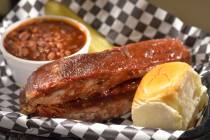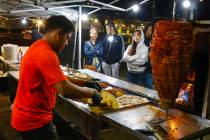Conquer winter’s chill with cassoulet
It's kinda chilly outside these days, which is prompting cooks all over the valley to haul out the stockpots and slow cookers and put together hearty concoctions to provide some warmth on a cold winter's night. But really, how many chilis, stews, braises and soups can you eat?
So here's a suggestion: Try a cassoulet, an ancient French dish of beans and meats and more.
"It's a perfect dish for winter," said Jeremy Berlin, executive chef of Gordon Ramsay Pub & Grill at Caesars Palace. "It's hearty, it's rich, it's comforting."
"That's a whole meal in itself," said Andre Rochat, chef/owner of Alize at the Palms and Andre's at the Monte Carlo. "You need a good bottle of wine for that. It's perfect for this kind of weather."
Berlin doesn't serve cassoulet in his restaurant, where the mission is English, not French, and Rochat said he makes it only by advance request. But both retain fond memories of it from their days in France.
"It's revered," Berlin said. "It's one of those dishes that if you're in France and you go from one town to the next, each town says, 'This is the classic recipe.' "
He learned to make it from a chef who's a member of the Universal Cassoulet Academy. You see how seriously they take this in France?
There are three primary classic types of cassoulet known, according to "Larousse Gastronomique," as the "Trinity," "the 'Father' being the cassoulet from Castelnaudary, the 'Son' the cassoulet from Carcassone and the 'Holy Ghost' that from Toulouse." Berlin said he favors Toulouse style, characterized by, among other things, garlic-infused Toulouse sausage. But that's definitely not all.
"Chef used a whole pig's ear," Berlin said. "I slice them in half and do like a julienne of the pig's ear and then mix it into the cassoulet."
Rochat, a native of France, said cassoulet isn't a peasant dish, as many think.
"It's more what we called in the old time bourgeois," or of the middle class, he said.
Of the three main types, Rochat said the Toulouse is characterized by goose and dark sausage, the Carcassone by mutton, sausage and partridge, and the Castelnaudary - "the original one" - with pork, ham and bacon. All, he said, are most properly made with Soison beans, named after the town they made famous.
While earthenware is the traditional vessel, he said that today, stainless steel or cast iron are more commonly used.
As Rochat explains the procedure, he evokes rich images sure to make you hungry.
"You soak your beans and you precook the beans about halfway," Rochat said. "You roast your meat; the only one you're not going to roast is the goose, because you use a goose-leg confit.
"I line the bottom of the pot with pork rind; that way it doesn't burn on the bottom, and you get all that kind of a binding from the pork rind. You layer the meat and the beans and you cover all that with broth. And you bake it, and a crust forms on top. The traditional way is you break that crust six times, until all your meat is almost falling off the bone.
"Once it's almost finished, I sprinkle breadcrumbs on top and spread the breadcrumbs with duck fat and put it back in the oven so you have a nice crust. Then you fold everything in so the breadcrumbs bind all the beans and all the juices and everything like that."
Brian Howard, executive chef of Comme Ca at The Cosmopolitan of Las Vegas, said his restaurant serves cassoulet about once a week during the winter.
"It's a very popular item," he said. "It's a comforting dish that I think everybody's familiar with. Most cultures have some kind of bean stew, or some sort of casserole, slow-cooked like that. People gravitate to things that may bring back a childhood memory or touch base with some experience people have had."
He said he, too, prefers the Toulouse style, prepared with sausage made in-house.
"It's one of those dishes like spaghetti and meatballs; everybody has their own way of doing it," Howard said. He has seen luxury cassoulets made with lobster, foie gras and truffles, and deconstructed cassoulets.
OK, all of that sounds pretty involved, and unless you really enjoy elemental cooking, it may be beyond your level of patience, time and/or expertise in both cooking and sourcing. To wit: One recipe from "Larousse" calls for "the usual meat, vegetables, garlic and herbs," cooked "in a baker's oven (ideally fueled by mountain gorse)," and one that requires, among other ingredients, fresh pork rind, goose fat, boned shoulder of mutton, a leg of goose or duck and some homemade sausage.
For those up to a challenge (and/or the purists among us), we offer a fairly classic recipe, along with some variations.
CASSOULET
1 pound dried white beans (preferably Great Northern)
2 cups beef broth
1 tablespoon tomato paste
2 cups chopped onion (¾ pound)
3 tablespoons finely chopped garlic (6 large cloves; divided use)
1 (3-inch) piece celery, cut into thirds
3 fresh thyme sprigs
1 Turkish or ½ California bay leaf
3 whole cloves
3 fresh flat-leaf parsley sprigs, plus ½ cup chopped leaves
¼ teaspoon whole black peppercorns
1 (14-ounce) can stewed tomatoes, pureed or finely chopped with juice
4 confit duck legs (1¾ pound total; see note)
1 to 2 tablespoons olive oil (if necessary)
1 pound cooked garlic pork sausage (see note) or smoked pork kielbasa, cut crosswise into 1/3-inch-thick slices
2 cups coarse fresh breadcrumbs (preferably from a baguette)
1½ teaspoons salt
½ teaspoon black pepper
Cover beans with cold water by 2 inches in a large bowl and soak 8 to 12 hours. Drain in a colander.
Transfer beans to a 6- to 8-quart pot and bring to a boil with 8 cups cold water, broth, tomato paste, onion and 2 tablespoons garlic. Put celery, thyme, bay leaf, cloves, parsley sprigs and peppercorns in a piece of cheesecloth and tie into a bundle with string to make a bouquet garni. Add bouquet garni to beans, then reduce heat and simmer, uncovered, until beans are almost tender, 45 minutes to 1 hour. Stir in tomatoes with juice and simmer until beans are just tender, about 15 minutes more.
Prepare duck and sausage while beans simmer: Remove all skin and fat from duck legs and cut skin and fat into ½-inch pieces. Separate duck meat from bones, leaving it in large pieces, and transfer meat to a bowl. Add bones to bean pot.
Cook duck skin and fat with ¼ cup cold water in a 10-inch heavy skillet over moderate heat, stirring, until water is evaporated and fat is rendered, about 5 minutes. Continue to cook, stirring frequently, until skin is crisp, 3 to 6 minutes more. Transfer cracklings with a slotted spoon to paper towels to drain, leaving fat in skillet. (You should have about ¼ cup fat; if not, add olive oil.)
Brown sausage in batches in fat in skillet, then transfer to bowl with duck meat, reserving skillet.
Preheat oven to 350 degrees.
To make breadcrumb topping, add remaining tablespoon of garlic to fat in skillet and cook over moderate heat, stirring, 1 minute. Stir in breadcrumbs and cook, stirring, until pale golden, about 2 minutes. Remove from heat and stir in chopped parsley, ½ teaspoon salt, ¼ teaspoon pepper and cracklings.
To assemble cassoulet, remove bouquet garni and duck bones from beans and discard, then stir in kielbasa, duck meat, remaining teaspoon salt and remaining ¼ teaspoon pepper.
Ladle cassoulet into casserole dish, distributing meat and beans evenly. (Meat and beans should be level with liquid; if they are submerged, ladle excess liquid back into pot and boil until reduced, then pour back into casserole dish.) Spread breadcrumb topping evenly over cassoulet and bake, uncovered, in lower third of oven, until bubbling and crust is golden, about 1 hour.
Cassoulet can be assembled (but not baked) 1 day ahead. Cool casserole before adding topping, then top and chill, loosely covered. Let stand at room temperature 30 minutes before baking.
Note: Duck confit and garlic sausage are available from some butchers and online sources, or you can make either at home.
Serves 6 to 8.
- Recipe from Gourmet magazine
VEGETARIAN CASSOULET
For cassoulet:
3 medium leeks (white and pale green parts only)
4 medium carrots, halved lengthwise and cut into 1-inch-wide pieces
3 celery ribs, cut into 1-inch-wide pieces
4 garlic cloves, chopped
¼ cup olive oil
4 thyme sprigs
2 parsley sprigs
1 Turkish or ½ California bay leaf
1/8 teaspoon ground cloves
3 (19-ounce) cans cannellini or Great Northern beans, rinsed and drained
1 quart water
For garlic crumbs:
4 cups coarse fresh breadcrumbs from a baguette
1/3 cup olive oil
1 tablespoon chopped garlic
¼ cup chopped parsley
To make cassoulet, halve leeks lengthwise and cut crosswise into ½-inch pieces, then wash well and pat dry.
Cook leeks, carrots, celery and garlic in oil with herb sprigs, bay leaf, cloves and ½ teaspoon each of salt and pepper in a large heavy pot over medium heat, stirring occasionally, until softened and golden, about 15 minutes. Stir in beans, then water, and simmer, partially covered, stirring occasionally, until carrots are tender but not falling apart, about 30 minutes.
Make garlic crumbs while cassoulet simmers:
Preheat oven to 350 degrees with rack in middle. Toss breadcrumbs with oil, garlic and ¼ teaspoon each of salt and pepper in a bowl until well coated. Spread in a baking pan and toast in oven, stirring once halfway through, until crisp and golden, 12 to 15 minutes.
Cool crumbs in pan, then return to bowl and stir in parsley.
To finish cassoulet, discard herb sprigs and bay leaf. Mash some of beans in pot with a potato masher or back of a spoon to thicken broth. Season with salt and pepper. Just before serving, sprinkle with garlic crumbs.
Serves 4 to 6.
- Recipe from Gourmet magazine
COUNTRY CASSOULET
1 pound (2 cups) dried Great Northern beans
2 fresh garlic sausage links
3 bacon strips, diced
1½ pounds boneless pork, cut into 1-inch cubes
1 pound boneless lamb, cut into 1-inch cubes
1½ cups chopped onion
3 garlic cloves, minced
2 teaspoons salt
1 teaspoon dried thyme
4 whole cloves
2 bay leaves
2½ cups chicken broth
1 can (8 ounces) tomato sauce
Sort beans and rinse with cold water. Place beans in a Dutch oven; add water to cover by 2 inches. Bring to a boil; boil for 2 minutes. Remove from the heat; cover and let stand for 1 to 4 hours, or until beans are softened. Drain and rinse beans, discarding liquid.
In a large skillet over medium-high heat, brown sausage; remove with a slotted spoon to a 5-quart slow cooker. Add bacon to skillet; cook until crisp. Remove with a slotted spoon to slow cooker.
In bacon drippings, cook pork and lamb until browned on all sides. Remove pork and lamb with a slotted spoon to slow cooker. Stir in beans and remaining ingredients. Cover and cook on high for 2 hours. Reduce heat to low and cook 3 to 4 hours longer. Discard cloves and bay leaves. Remove sausage and slice into ¼-inch pieces; return to slow cooker and stir gently.
Serves 8 to 10.
- Recipe from Taste of Home
THOMAS KELLER'S
SLOW-COOKER CASSOULET
4 pounds boneless pork shoulder, cut into 8 pieces and trimmed of excess fat
Kosher salt and freshly ground pepper, to taste
2 tablespoons canola oil
1 cup panko
4 ounces thick-cut bacon, cut crosswise into ½-inch strips
4 cups coarsely chopped yellow onions (about 3 medium onions)
2 cups dry white wine, such as sauvignon blanc
¼ cup tomato paste
1 can (35 ounces) peeled Italian plum tomatoes, drained and coarsely chopped
2 cups chicken broth
12 cups cooked Great Northern beans or other small white beans, drained
6 fully cooked or smoked chorizo or garlic sausage links, about 1½ pounds total, each halved on the diagonal
1 garlic head, halved crosswise
¼ cup chopped fresh flat-leaf parsley, plus more for garnish
1 1-pound baguette, cut into ½-inch-thick slices
Extra-virgin olive oil for brushing
Coarse sea salt, such as sel gris, for garnish
Season the pork generously with kosher salt and pepper; set aside.
In the stovetop-safe insert of a slow cooker (or in a large saucepan) over medium-high heat, combine the canola oil and panko. Cook, stirring constantly, until the panko is toasted and golden, 4 to 6 minutes. Transfer the panko to a baking sheet and season with kosher salt and pepper.
Add the bacon to the insert or pan and cook until crisp on both sides, about 5 minutes. Drain on paper towels. Reserve the bacon fat in the insert.
Add half of the pork to the insert or pan and brown on all sides, 7 to 8 minutes total. Transfer to a platter. Repeat with the remaining pork.
Add the onions and 1 teaspoon kosher salt to the insert or pan and cook, stirring occasionally, until golden brown and softened, about 7 minutes. Add the wine and simmer until reduced by half, about 8 minutes. Stir in the tomato paste, tomatoes and broth. Remove from heat and add the beans, pork, chorizo and garlic.
Place the insert on the slow-cooker base (or empty pan into slow-cooker insert, scraping drippings and browned bits from pan); cover and cook on low until the pork pulls apart easily with a fork, 9 to 10 hours. Skim off the fat, and remove and discard the garlic. Fold in the panko and the ¼ cup parsley. Adjust the seasonings with kosher salt and pepper.
Position a rack in the lower third of an oven and preheat the broiler.
Brush the baguette slices with olive oil. Arrange the slices, oiled side up, on top of the cassoulet (or on a sheet pan, if your insert isn't broiler-safe), overlapping them. Broil until golden brown, 4 to 6 minutes. (If using a sheet pan, remove slices and arrange on top of cassoulet.) Let the cassoulet stand at room temperature for about 30 minutes before serving. Sprinkle each serving with the reserved bacon, sea salt and parsley.
Serves 8 to 10.
Notes: Be sure to use precooked Spanish-style chorizo sausage links, not fresh Mexican-style chorizo. Spanish chorizo is available in a variety of textures; purchase a softer-style sausage, rather than a dry one, for this dish. Dry sausages are best suited for slicing and eating on their own, as a tapa.
- Recipe from Williams-Sonoma; adapted from a recipe by Thomas Keller
Contact reporter Heidi Knapp Rinella at hrinella@reviewjournal.com or 702-383-0474.























